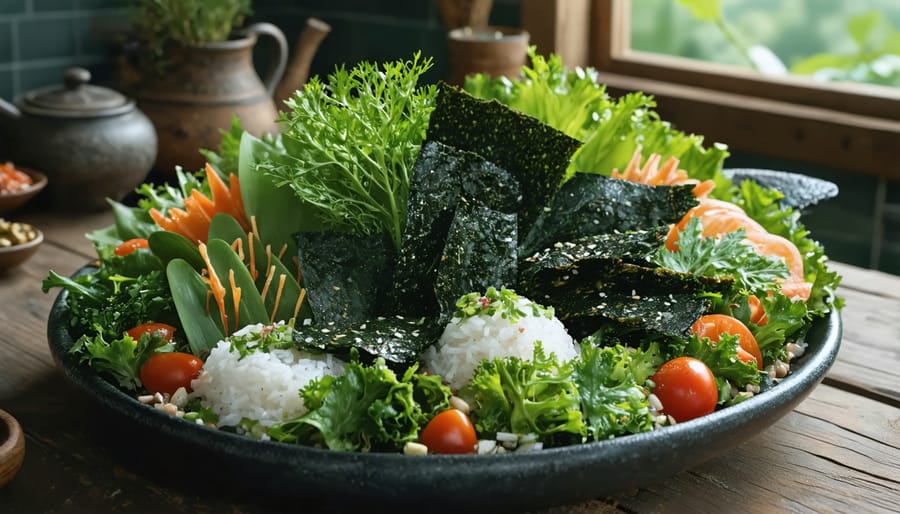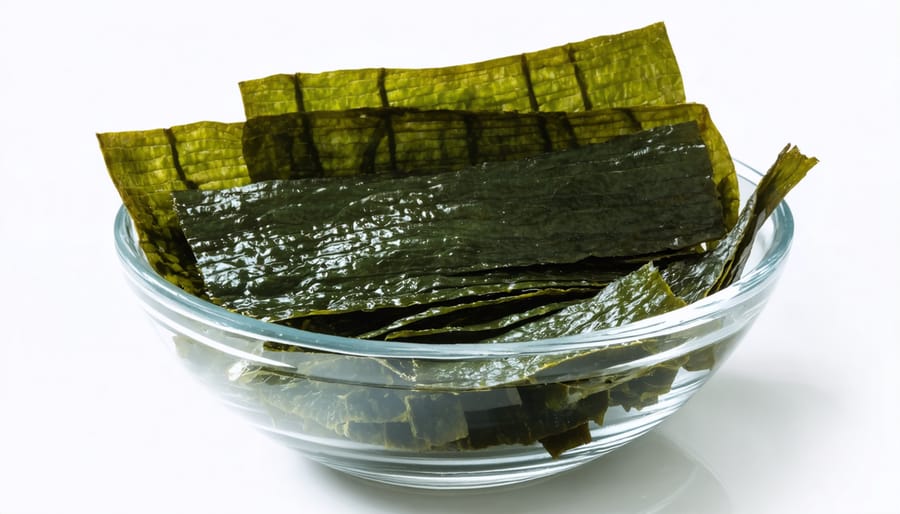
Transform your everyday cooking with seaweed’s umami-rich flavors, following centuries of tradition in Japanese seafood cuisine. Start by crumbling dried nori over steamed rice, roasted vegetables, or salads for an instant mineral-rich boost. Soak wakame in cool water for 5 minutes until it unfurls like sea silk, then toss it into miso soup or create a vibrant seaweed salad with sesame oil and rice vinegar. Keep kombu in your pantry to craft deeply flavored broths – simply add a strip to simmering water for 20 minutes to release its natural glutamates.
For newcomers to ocean vegetables, think of seaweed as nature’s seasoning – a pinch adds depth to any dish while delivering a wealth of nutrients. Whether you’re crafting homemade sushi rolls or elevating your weeknight stir-fry, these versatile sea vegetables offer an accessible way to bring restaurant-worthy umami to your home kitchen. From the tender leaves of sea lettuce to the crispy sheets of nori, seaweed’s range of textures and flavors opens up a world of culinary possibilities that go far beyond traditional Asian dishes.
Getting Started with Seaweed: Types and Selection

Popular Seaweed Varieties for Home Cooking
Let me take you on a delightful journey through the most versatile seaweed varieties you’ll love having in your kitchen. When I first started experimenting with seaweed, I was amazed at how each type brings its own unique flavor and texture to dishes.
Nori is probably the one you’re most familiar with – those dark, paper-thin sheets that wrap your favorite sushi rolls. But did you know you can also crumble it over salads or rice bowls for a delicious umami boost? I love keeping a pack in my pantry for quick rice ball wraps or as a creative sandwich layer.
Wakame is that beautiful, emerald-green seaweed you often find in miso soup. Once rehydrated, it transforms from a dried strip into silky, tender ribbons. It’s perfect in Japanese-inspired cucumber salads or added to clear broths. A little goes a long way – it expands considerably when soaked!
Kombu is the secret weapon behind dashi, Japanese cooking stock. This thick, dark seaweed adds incredible depth to broths and makes beans more digestible when added during cooking. I always keep a piece in the pot while cooking rice – it adds such wonderful flavor and nutrients.
Dulse might be less familiar, but it’s incredibly versatile. This reddish-purple seaweed has a naturally smoky, slightly salty taste that some say reminds them of bacon when pan-fried (yes, really!). Try it straight from the package as a snack, or crumble it over roasted vegetables for an extra flavor dimension.
Remember, all these seaweeds are packed with minerals and can be found in most Asian grocery stores or health food shops. Start with small amounts as you experiment – you’ll be amazed at how these ocean vegetables can transform your cooking!
Shopping and Storage Tips
When shopping for seaweed, your local Asian market is often the best place to start, though many mainstream grocery stores now stock basic varieties. Look for packages that are tightly sealed and free from moisture, as dampness can lead to spoilage. Just like with seasonal sourcing, quality matters – choose brands that clearly label their origin and harvesting date.
Store dried seaweed in an airtight container in a cool, dark place, where it can last for up to a year. For extra protection against humidity, add a food-grade silica packet to your storage container. Once opened, some varieties like nori can become stale quickly, so I always transfer them to a resealable plastic bag and squeeze out as much air as possible.
Fresh seaweed should be used within a few days and kept in the refrigerator, wrapped in damp paper towels and stored in a plastic bag. If you notice any strong fishy smell or slimy texture, it’s best to discard it. I’ve learned through experience that freezing fresh seaweed isn’t recommended, as it can significantly alter the texture.
Essential Seaweed Preparation Techniques
Rehydrating and Cleaning
Let me share a little secret that transformed my seaweed cooking game: proper rehydration is key to unlocking those amazing ocean flavors! Start by giving your dried seaweed a quick inspection – you want to make sure it’s free from any discoloration or suspicious spots.
For most varieties, you’ll want to soak the seaweed in cool water for about 5-10 minutes. I like to use a large bowl with plenty of room, as the seaweed will expand significantly – trust me, I learned this the hard way! You’ll notice it becoming silky and more vibrant in color as it rehydrates.
While soaking, gently swish the seaweed around to remove any sand or salt crystals. Once it’s fully hydrated, drain and give it a final rinse under cool running water. Pat it dry with a clean kitchen towel if you’re using it in a salad, or leave it slightly damp for cooking.
Pro tip: Don’t soak it for too long, or you might lose some of those wonderful nutrients and flavors. If you’re working with nori sheets for sushi, remember these don’t need soaking – just a quick wipe with a damp cloth will do the trick!

Basic Cooking Methods
Getting started with seaweed is easier than you might think! As you develop your mindful cooking habits, you’ll discover that seaweed’s versatility makes it a joy to work with in the kitchen.
The simplest method is to rehydrate dried seaweed in cool water until it becomes soft and pliable – usually about 5-10 minutes. Once rehydrated, you can add it to soups, salads, or use it as a wrap. For nori sheets, no rehydration is necessary when making sushi rolls or using as a crispy garnish.
Simmering is another fantastic technique, especially for kombu. Add a strip to your pot while cooking rice or beans – it infuses amazing umami flavor and helps make legumes more digestible. I love adding wakame to my miso soup during the last minute of cooking to maintain its tender texture.
For a crunchy twist, try toasting nori sheets briefly over an open flame or in a dry pan – it takes just seconds and creates a delightfully crispy snack. You can also crumble dried seaweed into flakes to sprinkle over finished dishes, adding both nutrition and a pop of ocean-fresh flavor to your meals.
Creative Ways to Use Seaweed in Everyday Cooking
Beyond Sushi: Modern Applications
Gone are the days when seaweed was confined to sushi rolls! I discovered this myself when experimenting with new ingredients in my kitchen, and now I’m excited to share how this versatile sea vegetable can transform your everyday cooking.
Let’s start with salads – my personal favorite way to incorporate seaweed. Try tossing strips of wakame with cucumber, sesame seeds, and a rice vinegar dressing for a refreshing side dish. Or add crispy nori strips to your regular green salad for a delightful umami crunch. One of my go-to lunch options is a quinoa bowl topped with dulse flakes, avocado, and cherry tomatoes.
Soups are another fantastic way to use seaweed. A handful of wakame or kombu can elevate a simple miso soup into something special, while adding mineral-rich flavor to vegetable broths. I love throwing some arame into my mushroom soup for extra depth and nutrition.
For main dishes, the possibilities are endless. Crumbled nori makes an excellent seasoning for roasted vegetables or as a topping for mac and cheese (trust me on this one!). You can wrap fish or vegetables in nori before baking for a moisture-sealed cooking method that infuses everything with wonderful oceanic flavors. I’ve even seen creative home cooks using seaweed as a pasta substitute in low-carb dishes.
Looking for something simpler? Try sprinkling dulse or kelp flakes on your popcorn, scrambled eggs, or roasted potatoes. They’re like nature’s salt shaker, adding both flavor and nutrients to everyday dishes. One of my community members recently shared how she uses seaweed to make a savory overnight oats bowl – proving that creativity knows no bounds when it comes to this ingredient!
Remember, starting small is key. Begin with familiar dishes and gradually experiment as you become more comfortable with these ocean-grown greens.

Seaweed as a Natural Flavor Enhancer
Have you ever wondered how restaurant chefs create such deeply flavorful dishes? One of their secret weapons might be hiding in plain sight: seaweed. As a natural flavor enhancer, seaweed has been used for centuries in Asian cuisine to add that elusive umami taste – the savory, mouth-filling sensation that makes food irresistibly delicious.
I discovered this game-changing ingredient while experimenting in my kitchen last summer, and it’s completely changed how I cook. The best part? You don’t need to make sushi or Asian dishes to benefit from seaweed’s flavor-boosting properties. Just a small amount can transform your meals from good to extraordinary.
Think of seaweed as nature’s MSG – but completely natural and packed with nutrients. Kombu, a type of kelp, works wonders when added to stocks, broths, and beans. Simply drop a strip into your pot while cooking, and it’ll infuse your dish with a rich, savory depth that’s hard to achieve otherwise. For those who love making homemade soups, try crumbling some dried wakame into the pot – it dissolves almost completely while amplifying all the other flavors.
Nori, the type commonly used for sushi rolls, can be crushed into flakes and sprinkled over finished dishes like you would salt and pepper. I love adding it to roasted vegetables, rice bowls, and even popcorn for an instant umami boost. And if you’re looking to reduce sodium in your cooking, seaweed’s natural salinity makes it an excellent alternative to table salt.
The key is starting small – a little goes a long way. Begin with just a small piece in your next pot of beans or soup, and you’ll be amazed at how it enhances the overall flavor profile without making your food taste like the ocean. Trust me, once you start cooking with seaweed, you’ll wonder how your kitchen ever functioned without it.
Health Benefits and Nutritional Value
When I first discovered seaweed beyond just sushi rolls, I was amazed to learn it’s practically a nutrient powerhouse hiding in plain sight! Let me tell you why this ocean vegetable deserves a spot in your weekly meal rotation.
Seaweed is incredibly rich in iodine, a mineral many of us don’t get enough of in our regular diets. This nutrient is essential for proper thyroid function and maintaining a healthy metabolism. Just one serving of nori or wakame can provide your daily recommended intake of iodine!
But that’s just the beginning of seaweed’s impressive nutritional resume. It’s packed with minerals like iron, calcium, and magnesium, making it especially beneficial for those following plant-based diets. I love knowing that when I sprinkle some dulse flakes on my salad, I’m getting a boost of these important nutrients.
What really surprised me was learning about seaweed’s protein content. While amounts vary by type, some varieties contain all the essential amino acids our bodies need – pretty remarkable for a sea vegetable! Plus, it’s naturally low in calories while being high in fiber, making it a fantastic addition to any weight-conscious eating plan.
The antioxidant content in seaweed is another reason to love it. These compounds help protect our cells from damage and may contribute to healthier-looking skin. Many of my friends have noticed improvements in their complexion after regularly incorporating seaweed into their diets.
Here’s something fascinating: seaweed contains unique compounds called fucoxanthin and fucoidan, which studies suggest may have anti-inflammatory properties and support immune function. While more research is ongoing, the potential health benefits are exciting!
For those watching their sodium intake but missing that savory taste in their food, seaweed offers a fantastic alternative. It provides that wonderful umami flavor while often containing less sodium than table salt, making it a smart choice for flavoring dishes.
Remember, as with any food, moderation is key – especially since seaweed’s high iodine content means you don’t need large amounts to reap the benefits. A little goes a long way in both nutrition and flavor!
As we wrap up our seaweed culinary adventure, I hope you’re feeling inspired to dive into this fascinating world of ocean-grown ingredients. I remember how intimidated I felt when I first held a sheet of nori, but now I can’t imagine my kitchen without these versatile sea vegetables. Whether you start small by sprinkling some wakame in your miso soup or go bold with a homemade sushi roll, there’s no wrong way to begin your seaweed journey.
Don’t be afraid to experiment – that’s how all great recipes are born! Try adding crushed nori to your popcorn for a unique movie night snack, or mix seaweed flakes into your morning smoothie. The possibilities are endless, and you might just discover your new favorite ingredient along the way.
Remember, incorporating seaweed into your cooking isn’t just about following trends – it’s about embracing a nutritious, sustainable ingredient that’s been cherished by coastal communities for centuries. So go ahead, pick up some seaweed on your next grocery run, and let your culinary creativity flow. Your taste buds (and your body) will thank you!



